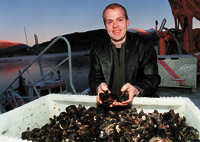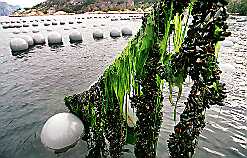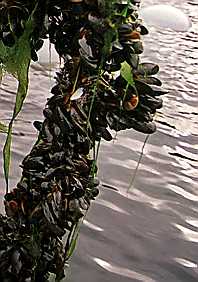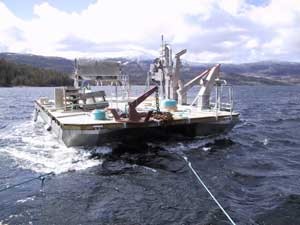|
SOME FACTS ABOUT MUSSELS
Blue mussel (Mytilus edilus)
 Approximately
l7 species of edible mussels are harvested or cultured worldwide. Approximately
l7 species of edible mussels are harvested or cultured worldwide.
The blue mussels, Mytilus edulis and Mytilus galloprovincialis,
are the most common species.
China leads the world in total tonnage of mussels harvested, with
Spain second, the United States l2th, and Canada ranking l9th.
France began its mussel cultivation by accident 700 years ago when
a shipwrecked Irish sailor Patrick Walton strung a net between two
poles in the ocean to catch seabirds for dinner. 
He found that the mussels growing on the poles made a hearty meal,
and so the "bouchot" industry was born. There are now
over 700 miles of mussel poles stitching the coast of France.
These oak poles are placed in long rows three feet apart in areas
where they and their delectable mussels are exposed at low tide.
The mussels can be thinned and harvested easily, but grow more slowly
because they are not submerged and feeding 'round the clock. Basically
family operations, these farms have the lowest meat yield per acre,
but France's long expanses of inter-tidal mud flats make this type
of cultivation ideal.
In Spain, culture on hanging
ropes began in l90l at Tarragona on the Mediterranean coast. In
the late l940's the Galacian region, which now comprises the bulk
of Spanish mussel production, entered into cultivation of M. edulis
and M. galloprovincialis.
Spain produced more than 200,000 metric tons of M. galloprovincialis
in l990. Three-quarters were consumed by Spaniards. Upward of 3500
mussel operations, many family-run, grow the mussels on huge rafts
from which ropes are suspended. This vertical use of the water column
results in the highest yield of any mussel operation in the world,
up to 300,000 pounds of meat per acre.
Mussels are cheap, easy
to find, not hard to prepare, and adapt to lots of different cooking
methods. Enjoy the recipes included here. 
Even though you will find mussels in the market year-round, don't
buy them during their spawning season, when their meat is mushy
and their shelf life reduced.
The ones you see most frequently are Atlantic blue mussels. For
them, spawning takes place in summer, so the best seasons are all
winter, and early spring.
Mediterranean mussels are grown in the Puget sound. The Mediterranean
spawns in winter, so its peak seasons are spring, summer and fall.
Large, green-lipped New Zealand mussels, known as greenshell mussel,
are usually only available frozen, so season is not an issue.
 When
buying fresh mussels, be sure they are live, with a tightly closed
shell, though they will gape when exposed to warmer temperatures;
their shells should close at least partially right away when you
tap or jostle them. When
buying fresh mussels, be sure they are live, with a tightly closed
shell, though they will gape when exposed to warmer temperatures;
their shells should close at least partially right away when you
tap or jostle them.
Mussels are usually graded by size, ranging from two to four inches.
Mussels can be wild or cultivated. Mussels grow in coastal waters
all around the world. In the wild, they are attached in clusters
by a tough thread to rocks, gravel, or any underwater surface they
can find.
Wild mussels rarely appear to market. They are easily recognizable
by their thick rough shells.
Most wild mussels contain sand, and the meats are smaller than those
of cultivated mussels.
When you buy mussels in the market labeled cultivated, it can mean
one of several things.
The price usually gives
a clue to how they were raised. The most expensive and best-quality
mussels are called "off-bottom" mussels, which are grown
on ropes or posts planted vertically in mussel farms.
MUSSELS FACTS.
When it comes to Omega-3, the miracle fatty acid found in fish,
mussels have more of it than any other shellfish.
One pound of mussels, in the shell, yields three and one-half ounces
of raw mussel meat or l00 grams that is the equivalent of 95 calories,
14 g. of protein, 2.1 g. of fat, .5 g saturated fat, 55 mg. cholesterol,
and sodium 284 mg.
- They filter water (up to 20 gallons a day!) 
- There are a wide variety of mussels to both fresh and saltwater.
- Easy to feed, Mussels can find 20 million edible tidbits to graze
on in just a liter of seawater.
- They can walk. Mussels have an appendage called a foot, that enables
them crawl.
- Mussels can live up to 50 years!
- The mantles of lady mussels are orange, gents are creamy white.
- During spawning, mussels can lose up to a third of their body
weight. It is not recommended to buy mussels during spawning season,
when their meat is mushy and their shelf life reduced.
|

